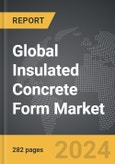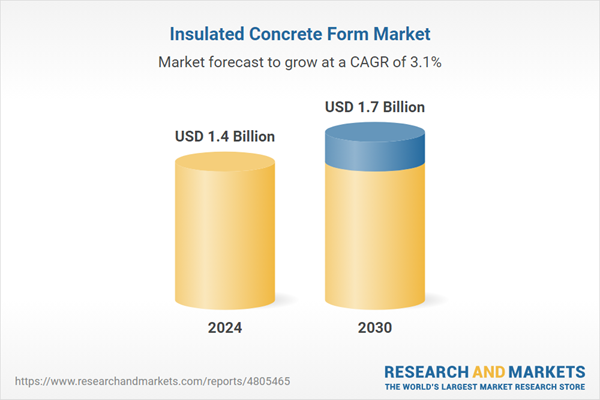The global market for Insulated Concrete Form was valued at US$1.4 Billion in 2024 and is projected to reach US$1.7 Billion by 2030, growing at a CAGR of 3.1% from 2024 to 2030. This comprehensive report provides an in-depth analysis of market trends, drivers, and forecasts, helping you make informed business decisions. The report includes the most recent global tariff developments and how they impact the Insulated Concrete Form market.
Segments: Material (Expanded Polystyrene Foams, Polyurethane Foams, Other Materials); End-Use (Residential, Non-Residential).
Geographic Regions/Countries: World; United States; Canada; Japan; China; Europe (France; Germany; Italy; United Kingdom; Spain; Russia; and Rest of Europe); Asia-Pacific (Australia; India; South Korea; and Rest of Asia-Pacific); Latin America (Argentina; Brazil; Mexico; and Rest of Latin America); Middle East (Iran; Israel; Saudi Arabia; United Arab Emirates; and Rest of Middle East); and Africa.
The analysts continuously track trade developments worldwide, drawing insights from leading global economists and over 200 industry and policy institutions, including think tanks, trade organizations, and national economic advisory bodies. This intelligence is integrated into forecasting models to provide timely, data-driven analysis of emerging risks and opportunities.
Global Insulated Concrete Form Market - Key Trends & Drivers Summarized
What Are Insulated Concrete Forms and Why Are They Gaining Popularity?
Insulated Concrete Forms (ICFs) are a type of building system that combines the strength and durability of reinforced concrete with the insulating properties of foam panels. These forms are used to create structural walls that are energy-efficient, soundproof, and resistant to natural disasters such as hurricanes and earthquakes. ICFs consist of hollow blocks or panels made from expanded polystyrene (EPS) or other insulating materials, which are then filled with concrete to create a solid wall. This construction method is becoming increasingly popular in both residential and commercial building projects due to its ability to provide superior thermal insulation, reduce energy costs, and improve the overall sustainability of buildings. As the demand for energy-efficient and resilient construction solutions continues to grow, ICFs are being adopted by builders and developers around the world.How Are Technological Developments Influencing the Insulated Concrete Form Market?
The insulated concrete form market is being influenced by several technological developments that are enhancing the performance and versatility of these systems. Advances in materials science have led to the development of new types of foam panels that offer improved thermal insulation, fire resistance, and structural integrity. Additionally, innovations in concrete mixtures, such as the incorporation of recycled materials and additives that enhance durability and reduce environmental impact, are making ICFs an even more attractive option for sustainable construction. The integration of building information modeling (BIM) and other digital technologies is also facilitating the design and construction process, allowing for more precise planning and efficient installation of ICF systems. Furthermore, the increasing availability of prefabricated ICF components is simplifying construction processes and reducing labor costs, making ICFs more accessible to a wider range of building projects.Why Is There a Growing Demand for Insulated Concrete Forms in Construction?
The demand for insulated concrete forms is growing in the construction industry due to the increasing focus on energy efficiency, sustainability, and resilience. In residential construction, homeowners are increasingly looking for building solutions that can reduce energy consumption and provide long-term savings on utility bills. ICFs offer a high level of thermal insulation, which helps to maintain stable indoor temperatures and reduce the need for heating and cooling, making them an ideal choice for energy-efficient homes. In commercial construction, the durability and disaster resistance of ICFs are key factors driving their adoption, particularly in regions prone to extreme weather events. Additionally, the growing emphasis on green building certifications and sustainable construction practices is leading developers to choose ICFs as part of their efforts to meet stringent environmental standards. As awareness of the benefits of ICFs continues to grow, so does their popularity in both new construction and retrofit projects.What Factors Are Driving the Growth in the Insulated Concrete Form Market?
The growth in the insulated concrete form market is driven by several factors that reflect the changing priorities of the construction industry. One of the main drivers is the increasing demand for energy-efficient building solutions, as builders and homeowners alike seek to reduce energy consumption and lower utility costs. This is particularly relevant in the context of rising energy prices and stricter building codes that require higher levels of thermal insulation. Another key factor is the growing awareness of the environmental impact of construction practices, leading to a greater emphasis on sustainable building materials and methods. ICFs, with their combination of energy efficiency, durability, and reduced environmental footprint, are well-positioned to meet these demands. Additionally, the increased frequency of natural disasters and the need for buildings that can withstand extreme weather conditions are driving the adoption of ICFs, especially in disaster-prone areas. Finally, the availability of government incentives and rebates for energy-efficient construction is encouraging more builders and developers to adopt ICFs, further contributing to the market's growth. As the construction industry continues to evolve, these factors are expected to sustain the upward trajectory of the insulated concrete form market.Report Scope
The report analyzes the Insulated Concrete Form market, presented in terms of units. The analysis covers the key segments and geographic regions outlined below.Segments: Material (Expanded Polystyrene Foams, Polyurethane Foams, Other Materials); End-Use (Residential, Non-Residential).
Geographic Regions/Countries: World; United States; Canada; Japan; China; Europe (France; Germany; Italy; United Kingdom; Spain; Russia; and Rest of Europe); Asia-Pacific (Australia; India; South Korea; and Rest of Asia-Pacific); Latin America (Argentina; Brazil; Mexico; and Rest of Latin America); Middle East (Iran; Israel; Saudi Arabia; United Arab Emirates; and Rest of Middle East); and Africa.
Key Insights:
- Market Growth: Understand the significant growth trajectory of the Expanded Polystyrene Foams segment, which is expected to reach US$825.9 Million by 2030 with a CAGR of a 3.7%. The Polyurethane Foams segment is also set to grow at 3.0% CAGR over the analysis period.
- Regional Analysis: Gain insights into the U.S. market, valued at $371.6 Million in 2024, and China, forecasted to grow at an impressive 5.7% CAGR to reach $343.9 Million by 2030. Discover growth trends in other key regions, including Japan, Canada, Germany, and the Asia-Pacific.
Why You Should Buy This Report:
- Detailed Market Analysis: Access a thorough analysis of the Global Insulated Concrete Form Market, covering all major geographic regions and market segments.
- Competitive Insights: Get an overview of the competitive landscape, including the market presence of major players across different geographies.
- Future Trends and Drivers: Understand the key trends and drivers shaping the future of the Global Insulated Concrete Form Market.
- Actionable Insights: Benefit from actionable insights that can help you identify new revenue opportunities and make strategic business decisions.
Key Questions Answered:
- How is the Global Insulated Concrete Form Market expected to evolve by 2030?
- What are the main drivers and restraints affecting the market?
- Which market segments will grow the most over the forecast period?
- How will market shares for different regions and segments change by 2030?
- Who are the leading players in the market, and what are their prospects?
Report Features:
- Comprehensive Market Data: Independent analysis of annual sales and market forecasts in US$ Million from 2024 to 2030.
- In-Depth Regional Analysis: Detailed insights into key markets, including the U.S., China, Japan, Canada, Europe, Asia-Pacific, Latin America, Middle East, and Africa.
- Company Profiles: Coverage of players such as Amvic, Inc., BASF SE, Beco Products Ltd., Conform Global (SmartBlock), Durisol UK and more.
- Complimentary Updates: Receive free report updates for one year to keep you informed of the latest market developments.
Some of the 13 companies featured in this Insulated Concrete Form market report include:
- Amvic, Inc.
- BASF SE
- Beco Products Ltd.
- Conform Global (SmartBlock)
- Durisol UK
- Fox Blocks
- KORE Wireless Group, Inc.
- Liteform
- Logix Insulated Concrete Forms Ltd.
- Nudura Corporation
- Polycrete International
- Quad-Lock Building Systems.
- Rastra
- Sunbloc
Tariff Impact Analysis: Key Insights for 2025
Global tariff negotiations across 180+ countries are reshaping supply chains, costs, and competitiveness. This report reflects the latest developments as of April 2025 and incorporates forward-looking insights into the market outlook.The analysts continuously track trade developments worldwide, drawing insights from leading global economists and over 200 industry and policy institutions, including think tanks, trade organizations, and national economic advisory bodies. This intelligence is integrated into forecasting models to provide timely, data-driven analysis of emerging risks and opportunities.
What’s Included in This Edition:
- Tariff-adjusted market forecasts by region and segment
- Analysis of cost and supply chain implications by sourcing and trade exposure
- Strategic insights into geographic shifts
Buyers receive a free July 2025 update with:
- Finalized tariff impacts and new trade agreement effects
- Updated projections reflecting global sourcing and cost shifts
- Expanded country-specific coverage across the industry
Table of Contents
I. METHODOLOGYII. EXECUTIVE SUMMARY2. FOCUS ON SELECT PLAYERSIII. MARKET ANALYSISSOUTH KOREAREST OF ASIA-PACIFICARGENTINABRAZILMEXICOREST OF LATIN AMERICAIRANISRAELSAUDI ARABIAUNITED ARAB EMIRATESREST OF MIDDLE EASTIV. COMPETITION
1. MARKET OVERVIEW
3. MARKET TRENDS & DRIVERS
4. GLOBAL MARKET PERSPECTIVE
UNITED STATES
CANADA
JAPAN
CHINA
EUROPE
FRANCE
GERMANY
ITALY
UNITED KINGDOM
SPAIN
RUSSIA
REST OF EUROPE
ASIA-PACIFIC
AUSTRALIA
INDIA
LATIN AMERICA
MIDDLE EAST
AFRICA
Companies Mentioned (Partial List)
A selection of companies mentioned in this report includes, but is not limited to:
- Amvic, Inc.
- BASF SE
- Beco Products Ltd.
- Conform Global (SmartBlock)
- Durisol UK
- Fox Blocks
- KORE Wireless Group, Inc.
- Liteform
- Logix Insulated Concrete Forms Ltd.
- Nudura Corporation
- Polycrete International
- Quad-Lock Building Systems.
- Rastra
- Sunbloc
Table Information
| Report Attribute | Details |
|---|---|
| No. of Pages | 282 |
| Published | April 2025 |
| Forecast Period | 2024 - 2030 |
| Estimated Market Value ( USD | $ 1.4 Billion |
| Forecasted Market Value ( USD | $ 1.7 Billion |
| Compound Annual Growth Rate | 3.1% |
| Regions Covered | Global |









